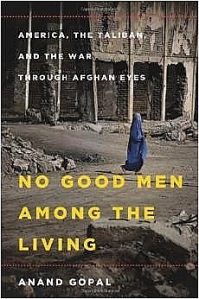In the land of broken truths
Updated on 05 April 2024
Anand GOPAL (2014): No good men among the living. America, the Taliban, and the war through Afghan eyes. Holt, New York
Truth is like broken glass – shards everywhere, some big, some small. Pick one up, and one might be tempted to imagine the whole view from the window (if the angle is light, it may reflect the viewer’s view – the perfect selfie). If one wants the “truth” about Afghanistan, one can read the last few pages of this book. In simple words, it tells how the country buckled under the American field force, wrapping itself around the occupiers and turning foreign power to the advantage of some and the destruction of many.[1] Otherwise, one can go for “metrics” and success indices, never being able to verify whether they are phantom or true, or what they mean for people’s lives there.
Only, by observing from the outside and classifying reality in abstract categories one misses the community’s “concrete historical experience and its stigmata of trauma and strife, of interference and rupture with the past, as well as the boon of continuity, of successful adaptation and adjustment.”[2] Even this would not be enough. One needs to dig deeper and ask “What does it feel to be an Afghan?”[3] This is the question the book tries to answer – and to a great extent succeeds.
The author has picked a few survivors and, in an extended series of interviews (here summarized as a running narrative), has tried to portray the necessities and unimaginable contingencies that shaped their reactions. He explores their feelings, their nightmares, their hopes, their moments of despair, their intuitions, their unexpected sources of strength. He concludes: “To win a war like this was to master the ephemeral, to plan a future while knowing that it could all be over in an instant. To comfort your children when the air throbs [from helicopters overhead] in the middle of the night, to squeeze your spouse’s hand tight when your taxi hits a pothole [that could hide an IED] on an open highway, to go to school or the fields or a wedding and return to tell about it. To survive.” (pg. 276). Along the way, some of his “survivors” met their fate in an ambush, or ended up in Bagram prison.
To survive is everything, and this explains the title of the book. It is the first half of a common Afghan proverb: “There are no good men among the living, and no bad ones among the dead.” (pg. 2) “Good” or “bad” are facile moral judgments: in the end, surviving is all that matters.
Reading this account puts paid to Western categories like “identity” and “ideology.” After the American invasion, the Taliban and the al-Qaeda movement had vanished (not unlike Nazism in Germany after 1945) in a silent but profound transformation of, if you wish, triangulation to the new power structure. By going after ghosts and demanding metrics of anti-terrorist success, the US snatched defeat from the jaws of victory. The US effort was predicated on “legibility” of progress, “evidence-based” results, projections, direction, when in fact everything was fluid, shifting, and hidden under layers and layers of ambiguity. The intricacies of power – the ability to change a person’s behavior tactically – fully escapes “metric” measurements, which measure position, rather than change. But “legibility” is a way of making the world flat; it is like arguing that, looking at the ocean’s surface, one can fathom its secrets.[4]
Another grievous error was the US belief that ideas make people, and that such people, once infected, would remain so – hence the need for purging them from the social system.[5] Experience shapes feelings, which may eventually be verbalized in ideology. Ideas follow and do not precede experience. Only by living and sharing the experience does one become aware of its evolution. Participation is everything. While one might not be able “to be like a bat,” the author proves that we have powers “good enough” to make a difference, if we are truly committed to a goal, and not a metric.
Given the approach the author chooses, one is spared the self-aggrandizing stance of the breathless reporter from the field and the crowding of facts clouding judgment. One understands more by knowing less. The slow, reflective style helps, for it leaves room for reflection, for letting the emotions resonate. This book reminds me a a masterpiece written long ago, dealing with the same topic: Fyodor DOSTOEVSKYs Demons.
_____________________
[1] The book quotes the US war commander General Stanley McCHRYSTAL in 2010: “We shot an amazing number of people, and to my knowledge, none has proven to have been a real threat.” (p. 253) In a different vein, the US spent 1’000 $ billion in Afghanistan, og which less than 6% went for development and governance. Much of the money pumped into the country was a bribe to strongmen (in form of security services) in order to be allowed to operate.
[2] Eric R. WOLF (1973): Peasant wars of the twentieth century. Harper & Row, New York.
[3] The philosopher Thomas NAGEL raised the issue: “What it is like to be a bat? in 1974. His paper became influential – at a theoretical level. It was one of the founding stones of “incommensurability” of experience.
[4] As a land-lubber species, we think in two dimensions. For u,s the world (and the social world) are essentially flat. Tri-dimensional ecologies, like the oceans, escape our comprehension.
[5] Interestingly, Pol Pot and Mao shared this “revolutionary” view. Intellectuals are prone to believe that they “make a difference” when, in fact, they are just commentators after the fact.


Leave a Reply
Want to join the discussion?Feel free to contribute!